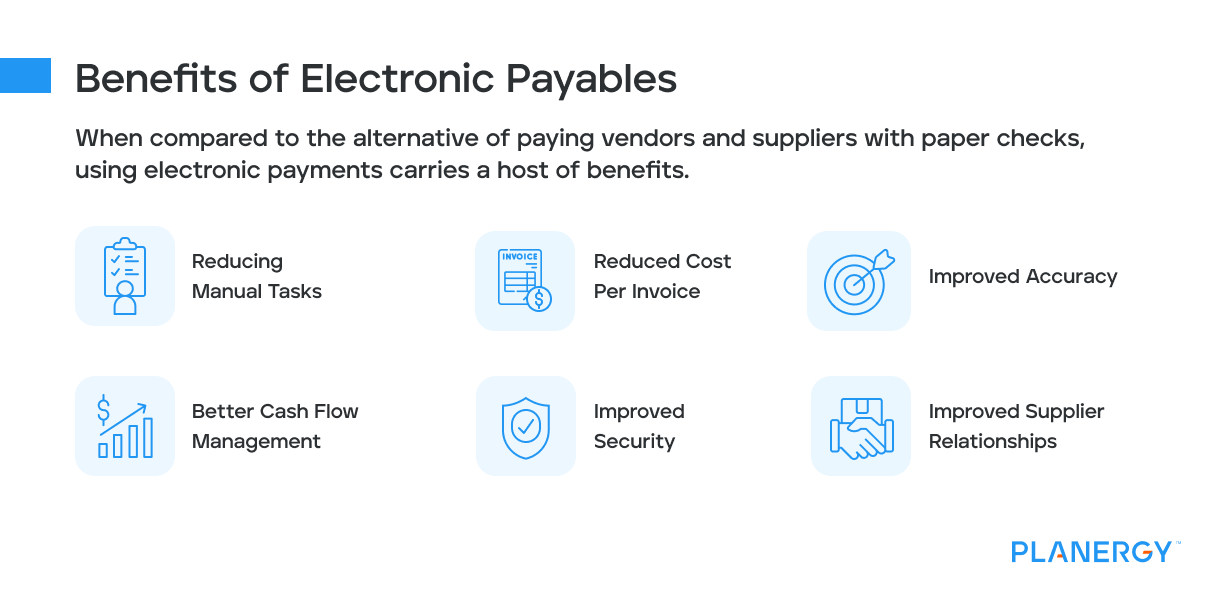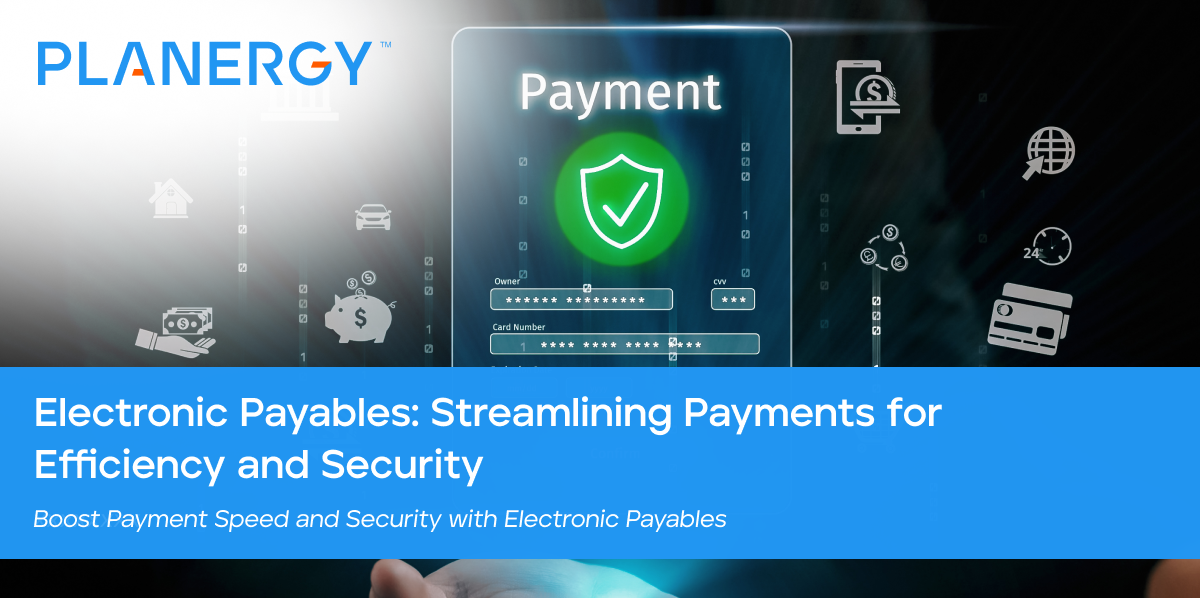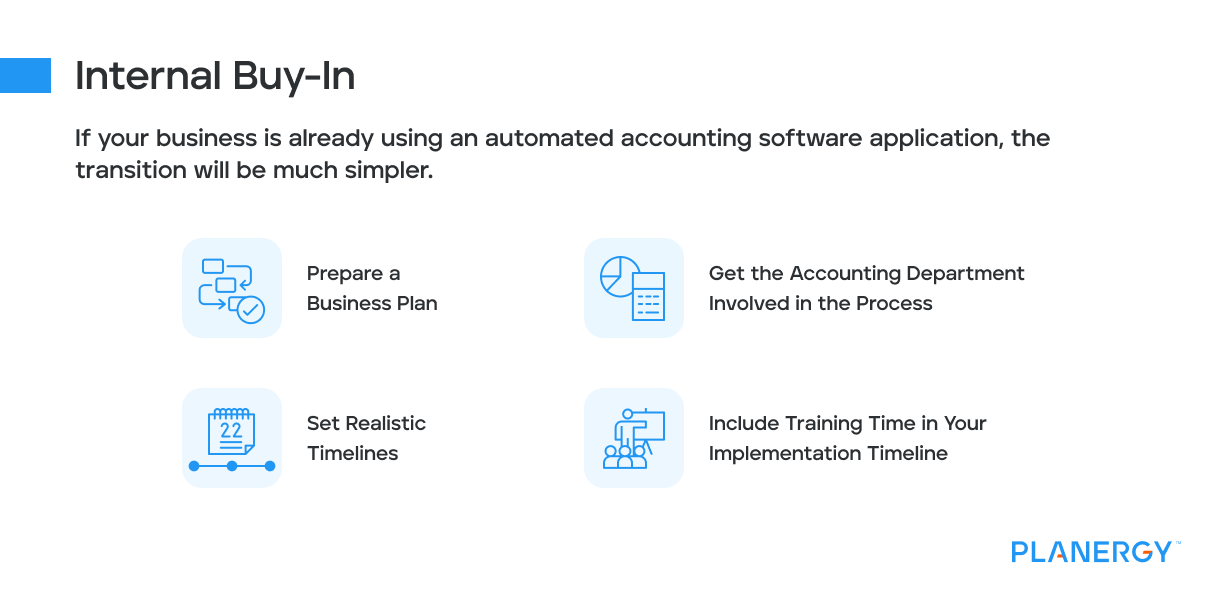For years, the standard process for paying vendors was issuing a check.
While checks are still an acceptable means of payment, there are several distinct disadvantages involved with check payments, including possible lost checks and check fraud.
While the vast majority of businesses still use paper checks as their primary method of payment, more businesses are adopting ePayables, which simplifies the payment process and eliminates all of the risks and extra work that paper checks require.
We’ll explain exactly what electronic payables or ePayables are, how they work, and why they may be a solution for your business.
What Are Electronic Payables?
Electronic payables or ePayables use an electronic payment system to pay vendors and suppliers using a virtual card.
This card, issued by a provider such as a bank, is similar to a debit or credit card, uses a unique 16-digit number, and has an expiration date and CVC code, but is completely digital.
How Do ePayables Work?
Once you have the appropriate application in place to utilize the ePayable process, you can follow these seven easy steps.
Notify your vendors and suppliers about your decision to start using ePayables.
This will give them time to get used to the situation and decide whether to participate.
Remember, the more vendors that participate, the easier it will be to process future payments.
Assign participating vendors and suppliers a unique virtual card during the enrollment process, which includes all account information specific to each vendor.
The card will have a 16-digit card number, an expiration date, and a CVC code.
Review and process invoices received from the vendor or supplier as usual.
Route the invoice for payment approval and payment.
Once the invoice has been approved for payment, you will need to send an electronic file to your business banking institute that includes payment details for each vendor or supplier you wish to pay.
That same amount is then funded onto the virtual card that has been assigned to the vendor or supplier.
Once the virtual cards have been funded, the vendor or supplier will receive notification that payment has been added to their virtual card, along with relevant payment information.
The vendor or supplier will then have to process the payment on their end, which will charge the buyer’s bank account or credit card for the payment, which is the final step in the workflow process.
The Evolution of Electronic Payment Methods in Business
Before electronic payments, most things were paid for with cash or a check payment.
The introduction of credit cards allowed businesses to pay for items without the use of either.
But not all businesses were happy about running up expenses on a credit card, so banks and other financial institutions introduced debit cards, which gave business owners the flexibility of a credit card transaction but withdrew the funds directly from their bank account instead.
Next was the Electronic Funds Transfer or EFT, which allowed businesses to make online payments to vendors and suppliers.
EFT and ACH payments also quickly became the favored payment method for payroll direct deposit.
Apps like PayPal then entered the picture, along with mobile payments and digital wallets, where payments could be completed from an electronic device such as a smartphone or tablet.
EFT vs. ACH Payments
Both EFT and ACH payments refer to digital fund transfers, but EFT (Electronic Funds Transfer) is a broad category that encompasses a full range of electronic payments, while ACH (Automated Clearing House) refers to specific bank-to-bank transfers that are sent through the Automated Clearing House.
The biggest difference between the two is that all ACH transfers are considered electronic funds transfers, but all electronic transfers, including digital payments, mobile payments, and wire transfers, are considered EFTs.
Key Technologies in Electronic Payables
Key technologies in ePayables include AI-powered automation, Robotic Process Automation or RPA, and unified payment platforms, which provided the payment mechanism involved in using these virtual pay cards.
In addition, API capabilities allow you to seamlessly integrate your ERP or accounting software application to the technology needed to process ePayables.
Benefits of Electronic Payables
When compared to the alternative of paying vendors and suppliers with paper checks, using electronic payments carries a host of benefits.

Reducing Manual Tasks
Using an ePayables system can be beneficial for both buyers and sellers.
Buyers can eliminate a host of manual tasks by automating the AP process, including check printing, signing, stuffing, and mailing, while vendors and suppliers can eliminate tasks such as sorting and opening checks received in the mail, endorsing the checks, and depositing them.
Reduced Cost per Invoice
Using an ePayables system will significantly reduce expenses directly associated with making vendor payments using paper checks, including the cost of check stock, reduced ink and toner use, postage, and stop payment expenses.
Improved Accuracy
The majority of payables errors stem from manual processes. Eliminating those processes results in increased accuracy and reduces the risk of fraud.
Additionally, ePayables eliminates lost checks, checks routed to the wrong company or department, the need to place a stop payment on lost checks, and the need to reissue the lost check and all that goes with it all over again.
Better Cash Flow Management
Using an ePayables system allows you to strategically time payments, choosing to pay an invoice in a single business day or pay just before the payment is due to better optimize working capital.
Improved Security
Traditional payment methods such as paper checks and even bank transfers can be manipulated for fraudulent purposes.
Using ePayables eliminates those possibilities since the entire process is virtual.
Improved Supplier Relationships
Everyone likes to be paid quickly. With an average turnaround time of two days with ePayables, you can pay your vendors and suppliers quickly and accurately while eliminating payment delays and lost payments.
Ability To Take Advantage of Discounts
How many discounts have you passed up because you weren’t able to pay your vendors or suppliers on time?
With a fast turnaround, ePayables allows you to pay your vendors accurately and also be in a position to take any offered discounts.
Challenges of Implementing Electronic Payables
For all of its benefits, ePayables also present some challenges that need to be addressed. For businesses still using a manual accounting system, automation is key to implementing an ePayable system.
The other major obstacle is getting your vendors and suppliers on board to accept ePayables as a valid payment option, with vendors sometimes balking at the processing costs involved, similar to credit card payments.
The other issue small businesses may face is the need to update their technology.
If you’re still using a manual accounting system to process payables or a mixture of multiple software applications, you’ll be unable to utilize the ePayables system since it’s built on automation.
A steep learning curve may also pose an issue for those unfamiliar with electronic payment processing on both the buyer and the vendor side of the equation.
Finally, vendors or suppliers may balk at having to part of the ePayables process since they’re responsible for processing the payment on their end once they receive notification that the virtual card has been funded, though that may change as the process evolves.
Best Practices for Implementing E-Payables
ePayables offers benefits to both buyers and vendors, yet in many cases, one or both sides are reluctant to utilize the technology.
Identifying and resolving the challenges mentioned earlier is key to implementing ePayables since buy-in is required for both buyers and sellers.
Internal Buy-In
Using ePayables isn’t a decision that can be made in a silo. Multiple departments need to be on board before implementation.
If your business is already using an automated accounting software application, the transition will be much simpler.

Prepare a Business Plan
Preparing a business plan for how ePayables will benefit your business is key to getting cooperation from all sides.
The business plan should also include a realistic timeline for implementation.
Get the Accounting Department Involved in the Process
While getting the approval of stakeholders is essential, the accounting team will be the most impacted by the decision to implement ePayables.
Having your AP staff involved in the transition process from the beginning will make the entire process go smoother from start to finish.
Set Realistic Timelines
When creating an implementation plan and timeline, be sure to consider your current automation capability and what needs to be completed.
For instance, if you’re simply adding ePayables capability using your current accounting software or ERP, your implementation time will be much quicker than if you’re first moving to automation and then implementing ePayables.
Include Training Time in Your Implementation Timeline
Consider the level of training that will be required.
Will your employees simply need to learn the ePayables system, or will they also have to be trained on an entirely new accounting software application?
Unless your employees have already used ePayables, they’ll need to be properly trained before implementation.
External Buy-In
While convincing your AP team and the CFO that moving to ePayables is a great idea, you’ll still have to convince your vendors and suppliers as well.
Without vendor and supplier enrollment, moving to ePayables is impossible. What is the best way to get them on board?
Create a communication strategy that highlights the benefits of ePayables for vendors.
While some businesses will start soliciting a select group of vendors, it’s important to communicate your plans and the benefits to all of your vendors.
Be sure to contact your vendors at the appropriate time.
Don’t contact them before you’ve decided to use ePayables. Wait until your staff is properly trained and the system is ready to go.
Communicate your plans effectively. For some vendors and suppliers, this may mean a telephone call, while others may prefer to be contacted with your plans via email.
Be sure that any communication includes a detailed list of vendor benefits.
Offering an incentive such as expedited payment may help sweeten the pot, particularly for smaller businesses that need to increase cash flow.
Get key stakeholders involved. Sometimes, a call from a CFO or CEO is enough to convince reluctant vendors or suppliers to participate.
The Future of Electronic Payables
As more businesses look to make the move to AP automation and automating the accounts payable process, ePayables will become more common.
Ardent Partners – The State of ePayables 2023 states that organizations looking to implement an ePayables strategy for their business must have the following characteristics:
- Comprehensive automation capability
- The ability to react quickly to real-time pressures and challenges
- Data mining capabilities that help identify cost-saving options, detect fraud, and support both cash and supplier management
- Solid relationships with partners are key to ePayables’ success
- A culture of innovation that openly encourages staff to utilize the latest technologies and an openness to adopt new technology
A successful ePayables implementation benefits buyers and vendors alike, streamlining the payables process from start to finish.





